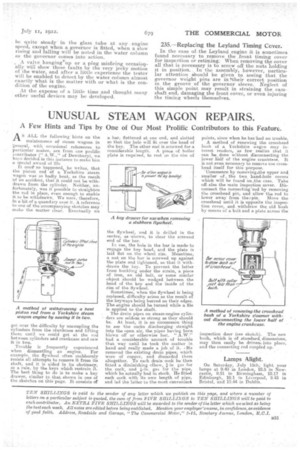UNUSUAL STEAM WAGON REPAIRS.
Page 29

If you've noticed an error in this article please click here to report it so we can fix it.
A Few Hints and Tips by One of Our Most Prolific Contributors to this Feature.
S ALL the following hints on the maintenance of steam wagons in general, with occasional references to particular makes, are from one prolific contributor (" A.W.," of Dewsbury), we have decided in this instance to make him a special award of 25s
It onet so happened, he writes, that the piston rod of a Yorkshire steam wagon was so badly bent, as the result Of an accident, that it could not be withdrawn from the cylinder. Neither, unfortunately, was it possible to straighten the red in place, even enough to enable it to be withdrawn. We were, therefore, in a bit of a quandary over it. A reference to one of the accompanying sketches may make the matter clear. Eventually we
got over the difficulty by uncoupling the cylinders from the crankcase and lifting them until we could get at the rod between cylinders and crankcase and saw it in two.
Trouble is frequently experienced when dismantling an engine. For example, the flywheel often stubbornly resists all attempts to remove it from its shaft, and it is aided in its obstinacy, as a rule, by the keys which restrain it. The best thing to do is to make a key drawer, similar to that, shown in one of the sketches on this page. It consists of a bar, flattened at one end, and slotted so that the hole will fit over the head of the key. The other end is screwed for a considerable length. A piece of boiler plate is required, to rest on the rim of the flywheel, and it is drilled in the centre, as •shown, to clear the screwed end of the bar.
ILl use, the hole in the bar is made to engage the key head, and the plate is laid fiat on the wheel rim. Meantime, a nut on the bar is screwed up against the plate and tightened, so that it Withdraws the key. To prevent the latter from buckling under the strain, a piece of iron, an old bolt, or some similar object should be wedged between the head of the key and the inside of the rim of the flywheel.
Sometimes, when the flywheel is being replaced, difficulty arises as the result of the keyways being burred on their edges. The engine should be turned while a file is applied to the shaft. The drain pipes on steamLengine cylinders are seldom so strong as they should be. At least, it is 130 uncommon thing to see ithe cocks discharging' straight into the open air, the pipes having been blown off or otherwise lost. " A.W." had a considerable amount of trouble that way until he took the matter in hand and really made a job of it. Be removed the existing drain pipes, which were of copper, and discarded them altogether. To each drain cock he then fitted a diminishing elbow, t-in gas for the cock, and *.in. gas for the pipe, which he actually had in stock. He fitted each cock with its own length of pipe, and led the latter to the most convenient
points, since when he has had no trouble. A method of renewing the crosshead bush of a Yorkshire wagon may interest readers, as few realize that it can be done without disconnecting the lower lialf of the engine cranuct,se. It is not even necessary to remove wie crosshead itself for this purpose.
'Commence by removing,the upper and smaller of. the two hand-hole covers which will he found on ,the case. Take off, also the main inspection cover. Disconnect the connecting-rod by removing the crosshead pin, and allow the rod to lower away from the epin. Move the crosshead until it. is opposite the inspection cover, and, withdraw the, old bush by means of a bolt and a plate across the
inspection door (see sketch). The nee', bush, which is of standard, dimensions, may then easily be driven, into place, and the connecting rod coupled up.
Lamps Alight.
On Saturday, July 15th; light your lamps at 9.40 in London, 10.5 in Newcastle, 9.51 in Birmingham, 10.17 in Edinburgh, 10.1 in Liverpool, 9.45 in Bristol, and 10.44 in Dublin.






























